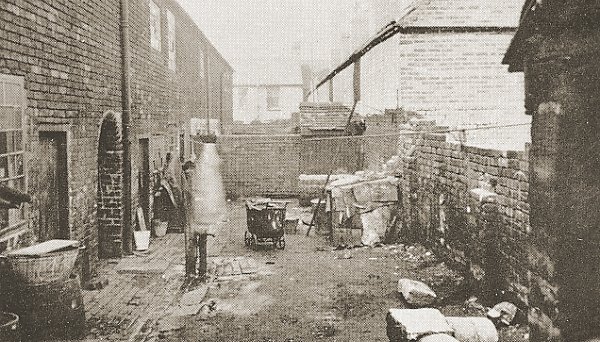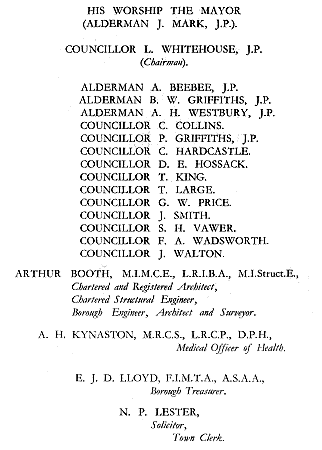|
Background
The
Housing Schemes
By the middle of the 19th century,
large parts of Wednesbury had been turned into an almost
lunar landscape, due to the intense coal mining that
took place in the area. The large reserves of coal
supplied a vast number of factories, both in the Black
Country and Birmingham, and led to the building of the
local canal.
Most of the population lived in
small, tightly-packed houses around the town centre,
built in areas that were unaffected by mining. As
industry began to dominate the area, people flocked to
the town to find employment, and the population rapidly
grew. This led to overcrowding, and poor, often
unsanitary living conditions. By the early years of the
20th century the situation had deteriorated to such an
extent that something had to be done.
In 1913 the Borough Council
appointed a sub-committee to look into the shortage of
housing and to report their findings to the Sanitary
Committee at the earliest possible date. After 12 months
the sub-committee came to the conclusion that its
members were satisfied with the existence of
overcrowding in the Borough, and the failure of private
enterprise to provide houses for a certain section of
the working classes. The Sanitary Committee then
recommended that an application should be made to the
Local Government Board for a loan of £5,240 for the
building of 24 council houses at Hobs Road, Wood Green.
This would have been a pilot scheme, enabling the
council to accurately cost future housing schemes, and
to discover any unforeseen problems.
The houses were to be built under
the terms of part 3 of the Housing of the Working
Classes Act of 1890. After a public enquiry, the scheme
did not receive the approval of the Ministry of Health.
The application was made at an unfortunate time,
coinciding with the start of the First World War. It was
rejected, but 21 houses were built in 1915 by a private
firm. |

The Town Hall and Art Gallery.
|
The shortage of housing nationally
became so acute that in July 1917 the government decided
to offer financial assistance to local authorities
immediately after the war, to encourage the growth of
municipal housing. In March 1918 a circular sent to
local authorities outlined the terms of the proposed
assistance that was (with modifications) included in
the Housing, Town Planning Act of 1919.
In 1919 the council sent the
results of a survey of housing needs to the Ministry of
Health, under the terms of the 1919 Housing Act. It
stated that for the estimated population of 32,089 there
were 6,108 houses, of which 5,077 were of the working
class type. Only an average of 32 houses were built each
year between 1910 and 1914, and practically none were
built between 1915 and 1918.
The 1919 Housing Act offered
generous assistance to local authorities. Under the
terms of the Act, no matter how many houses were
erected, the loss falling on the local authority would
not exceed the product of a penny rate. The incentive
was too good to miss, and so the council immediately
started a scheme to build 250 houses on the Wood Green
Estate and 108 houses on the Manor Farm Estate.
Although work on the new estates
soon began, the government subsidy only lasted for two
and a half years, after which building work stopped.
This was due to the effects of the recession, which led
to the 1923 Chamberlain Act under which there would be
no more subsidies for council house building, only for
private builders, or buildings for sale.
When Ramsay MacDonald became Prime
Minister in January 1924, he appointed John Wheatley as
his Minister of Health. Wheatley's Housing Act which
became law in August 1924 gave a higher subsidy for
council house building, with a contribution from the
rates. The Act offered a grant of £9 per year for 40
years for each house, but was subject to conditions, one
of which was that local authorities contribute
£4.10s.0d. per house per year, and that rents were not
allowed to exceed pre-war rent. In order to obtain the
£9 subsidy, the houses had to be let. If they were sold
the subsidy was reduced to £6 per house. |

Slum housing. The rear of 18 to 29 Hobbins
Street.
|
Initially, little was done in
Wednesbury until 1925 when the situation was noted by a
government inspector, who was very critical of the poor
housing conditions in the town. This resulted in
questions being asked in the House of Commons by Alfred
Short, the Borough's member of parliament, who came to
Wednesbury and made a scathing attack on the council.
The council took no action to remedy the situation until
1926, and only then because of the tempting government
subsidy, and the lack of private sector building.
The government’s subsidy was again
reduced under the terms of the Revision of Contribution
Order of 1926 which stated that the subsidy for any
houses built after the 30th September, would be reduced
to £7.10s.0d. for 40 years. At the same time the local
authorities' contribution was reduced from £4.10s.0d. to
£3.15s.0d.
Between 1926 and 1930 a total of
206 council houses were built at Mesty Croft, 144 houses
at Churchfields, 32 on the Holyhead Road, 26 in
Wellcroft Street, and 16 in Edward Street.
The Housing Act of 1930 encouraged
mass slum clearance and councils set to work to demolish
poor quality housing and replace it with new build. Slum
areas of housing existed in most inner city areas and
were generally old, neglected and unhealthy places to
live. Many of the houses, which had originally been
built for workers during the period of rapid industrial
development, were overcrowded and lacked amenities such
as an adequate water supply, ventilation and sunlight.
Using powers available under the Act to acquire and
demolish privately owned properties, slum clearance
schemes were put into action across the country.
|
|

The 1935 Health and Housing
Committee. |
The Act introduced a five year
programme for the clearance of slums, with designated
Improvement Areas. Local authorities had to provide
housing for those who lost their homes during slum
clearance, and were allowed to offer rent rebates
to those who needed special assistance.
By 1931 1,000 council houses were
occupied, and in 1933 a slum clearance scheme saw the
demolition of old houses in Queen Street, Moxley, Short
Street, and Portway Road. The 1933 Housing Act ended
subsidies for general housing, authorities were required
to concentrate their efforts on slum clearance.
The 1935 Housing Act required every
local authority to submit a programme of building and
demolition aimed at eliminating slums from their area.
The slum clearance programme in Wednesbury was enlarged,
and by 1935 the number of houses that had already been
demolished, or were about to be demolished reached
1,250; one 6th of all the houses in the town.
|
|
By 1944 there was an immediate need
for 700 houses and so reclamation work began at Park Lane
and Hobs Road, and a plan was put forward to build 1,420
council houses on 6 sites. At the time the total number
of inhabited houses in the town had reached 8,409, of which
3,088 were council properties.
Post war council housing estates
are found at Park Lane, Old Park Road, Dingley Road,
Crew Road, Friar Park, the Golf Course, Millfields,
Dangerfield Lane (Lodge Holes), Mesty Croft, Cross
Street and Balls Hill. Between the end of the war and
December 1958 nearly 2,000 council houses were built,
and in April 1959 the 5,000th council house had been
completed. Over 2,800 houses and old age pensioner
bungalows were completed after 1945. |
 |
|
 |
Return to
the contents |
|
Proceed to Reclamation |
|